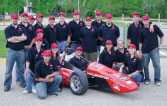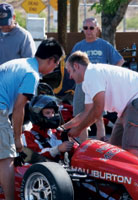The Formula for Success
Course integrates automotive engineering and life skills
 One lap. Five laps. Nine...Mechanical engineering students from the University of New Mexico watched with rapt attention as car #37, a bright red racecar, zipped around the autocross track at the Silverdome in Pontiac, Michigan. The car was racing in the endurance portion of the 2004 Formula Society of Automotive Engineers (FSAE) competition. FSAE, the largest international engineering competition in the world, challenges engineering students to design, build and race a formula style racecar in one year. The three-day event attracted 140 teams from as far away as Korea, Australia and Finland - all eager to,literally, test their metal.
One lap. Five laps. Nine...Mechanical engineering students from the University of New Mexico watched with rapt attention as car #37, a bright red racecar, zipped around the autocross track at the Silverdome in Pontiac, Michigan. The car was racing in the endurance portion of the 2004 Formula Society of Automotive Engineers (FSAE) competition. FSAE, the largest international engineering competition in the world, challenges engineering students to design, build and race a formula style racecar in one year. The three-day event attracted 140 teams from as far away as Korea, Australia and Finland - all eager to,literally, test their metal.
UNM's car, created by students enrolled in the 2004 FSAE Class, had already garnered an 11th place finish in the marketing presentation and 12th place for its head-turning design. Now the 80 horsepower, 488-pound car was being put to the test in a series of events evaluate its performance.
At lap 11, UNM's first driver pulled into the pit for the required stop and driver change. The engine was turned off. A new driver slipped into the seat, pushed the starter and...nothing.
In an attempt to score points on fuel economy, the team had created a very lean fuel mixture that caused the engine to overheat. So, the team received a "did not finish" or "DNF" for that part of the test. Team members' spirits were down after seeing the car sidelined. Yet, their team captain, mechanical engineering student Joshua Arvizu, and faculty adviser, Professor John Russell, were happy with the team’s performance.
Arvizu summed up the emotion of the moment saying, "Everyone had their head down because every single person on that team cared so much about the competition. That's when the team feeling really hit home. Although it felt like we'd failed, I thought we were a huge success because everyone worked so hard to achieve all the success we had this year."
Indeed, the team had excelled. The team finished 39th overall, a school record and a substantial improvement from last year's 62nd place. Their design and construction were also big advancements over last year's entry. Car #37 weighed 120 pounds less than its predecessor, and its unique, versatile design gave the car the capability to run in acceleration, skid pad, autocross and endurance events.
The UNM team may not have won a shiny trophy, but they came away from Pontiac with something far more valuable: knowledge, experience and friendships that will last a lifetime.
A Comprehensive Program
UNM students have competed in FSAE since 1997. At the time, it was a club that students could join on their own time. There was enough interest that the School of Engineering offered the competition as a one-semester class in 1999. But the course did not give Russell and his students enough time to approach the challenge in a comprehensive manner. "We simply could not meet the deadline for being ready for competition with a fully-tested car when we started in September and had to be ready by May," says Russell.
In 2003, this challenge was the impetus for UNM to become the only school in the country to offer a three-semester, for-credit FSAE course. The class is an alternative to the required senior design project in Mechanical Engineering. Students start the course in the spring semester of their junior year. First semester is dedicated to academic study; then students design and build the car in the fall, and test the car before the competition the following spring. The class structure creates an added learning opportunity because students starting the course in the spring overlap with the team that is preparing for the competition.
Students learn about racecar engineering and master the software required to design the car and manufacture all the parts, with the exception of the seatbelt, rims and engine. Then they construct the car, test it and prepare for the competition. Russell says UNM’s comprehensive course is about much more than the competition. "This class integrates every engineering course the students have ever had. The course puts it all together - academics, industrial project challenges like managing people, money and schedules, project design, and of course, the excitement of a sport."
 While Russell teaches the fundamentals and advises the team, the students are on their own when it comes to making decisions. The team determines all aspects of the project - from the team structure and the car's design, to the production schedule and how they will transport the car to the competition. "They're conditioned to get the answer to the problem at the end of the chapter. Here things are completely open-ended in terms of what to do. My job is to give them the tools to design the car. I don't do it for them. They have to pose the problems and then solve them," says Russell. He adds, "But I do retain veto authority." The team also has to have the design reviewed and approved by automotive engineers before it can be built.
While Russell teaches the fundamentals and advises the team, the students are on their own when it comes to making decisions. The team determines all aspects of the project - from the team structure and the car's design, to the production schedule and how they will transport the car to the competition. "They're conditioned to get the answer to the problem at the end of the chapter. Here things are completely open-ended in terms of what to do. My job is to give them the tools to design the car. I don't do it for them. They have to pose the problems and then solve them," says Russell. He adds, "But I do retain veto authority." The team also has to have the design reviewed and approved by automotive engineers before it can be built.
Building a racecar from the ground up costs money. This year the production cost - the price you would pay for the car if you bought it off the showroom floor - was a relatively affordable $19,000. The competition limits the production cost of the cars to $25,000, although teams can spend more for capital items required to design and build the car. The University contributed $20,000, including a $5,000 grant from the Ford Corporation. The team had to raise the rest of the money from student government allocations, private donors and fundraising projects. In total, they raised $20,000, which included $1,000 from a local Ford dealership. To keep sponsors up to date on their progress, the team produced five newsletters during the project and invited sponsors to come down to watch the test drives in an empty UNM parking lot.
Team Mechanics
While learning design software and asking companies for donations is tough, the real challenge of FSAE lies in managing the people who will make the car come to life.
The FSAE team functions like a small company with a team leader and managers who oversee different aspects of the project. Team members create and maintain schedules, assign tasks, requisition tools and manage all the administrative and paperwork details. "It's all on their own initiative. I’m not down there telling them that something needs to be done by a certain date. They have to set those dates. It has to be their drive that  does it," says Russell.
does it," says Russell.
One of the team's first tasks is to choose a team captain, the point person who manages the project and reports to Dr. Russell. The team chose Arvizu. As a 2003 team FSAE "alumni" because he was part of the 2003 team, a talented public speaker, and an energetic personality, he was an obvious choice. Arvizu admits that when he first started FSAE, he wasn’t a "car guy," and he was lost when it came to tools and the manufacturing process. But he jumped right in and the FSAE bug bit hard. "Going through the process once, and knowing that I had another year of school left, I thought to myself 'I have to do that again'," says Arvizu.
While not seeking the team captain role, Arvizu accepted it, knowing that it could help him grow. "This was my first real chance to prove to myself whether I can make it as a leader. I was excited about seeing what I could do. What it ended up doing is humbling me extremely," he says. "Managing the team dynamics was the hardest thing I had to deal with. Scheduling and the administrative side was easy compared to dealing with people, keeping them happy, keeping them working and motivated."
That is all part of the plan, according to Russell. "This course is designed like the workplace. They have to come up with an organizational structure and learn how to work within it. And they have to understand business ethics. It's just part of the bigger picture they'll need for their futures," says Russell.
This year's team had 30 students, seven of whom were women. One of the women, Heather Gorenz, designed the car's carbon fiber body. The high ratio of women was a first, according to Russell. “Having so many women on the team was new for us. It brought a new dynamic to the team, which was great," says Russell.
Taking The Checkered Flag
Russell says that he and the students have different goals when the class begins, but all goals converge at the finish line. "Their goal is to win the competition. My goal is to give them tools they can use when they graduate. The racecar is just a neat tool to show them project management, systems engineering and working as a team."
The experience has proven to be very valuable as students look for jobs, especially in the automotive field where companies weigh the FSAE experience heavily. Russell says he has heard of at least one major automotive company that requires four years of automotive engineering experience or just one year of participation in FSAE.
After months of stress, sleepless nights and weeks when he and the team put in upwards of 40 hours a week on the car, Arvizu says it was all worth it. "It's just the most rewarding thing I’ve done in my life. Sure, it's a competitive challenge. But in the end - and I know this is Dr. Russell's goal for us - it's not about that. You just gain so much experience as an engineer...so much value from the whole process."
Now a staff technologist at Sandia National Laboratories in Albuquerque, Arvizu says what he learned from FSAE has helped him in his current position. It will also serve him well this fall, as he heads to Stanford University to earn his master's in engineering.
 Car #37 now sits in the corner of the Lobo Motorsports shop. A shiny, new chassis rests in the center of the room. Pass the shop on any given day and you hear team members, metal on metal, power tools revving...the sounds of the next car, and well-rounded students, under construction.
Car #37 now sits in the corner of the Lobo Motorsports shop. A shiny, new chassis rests in the center of the room. Pass the shop on any given day and you hear team members, metal on metal, power tools revving...the sounds of the next car, and well-rounded students, under construction.
